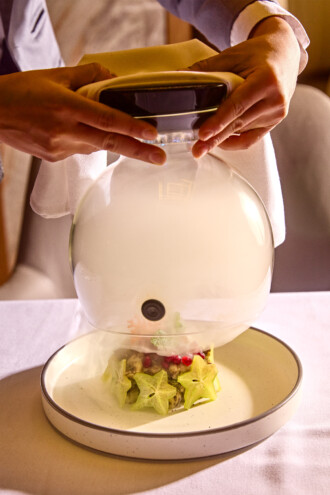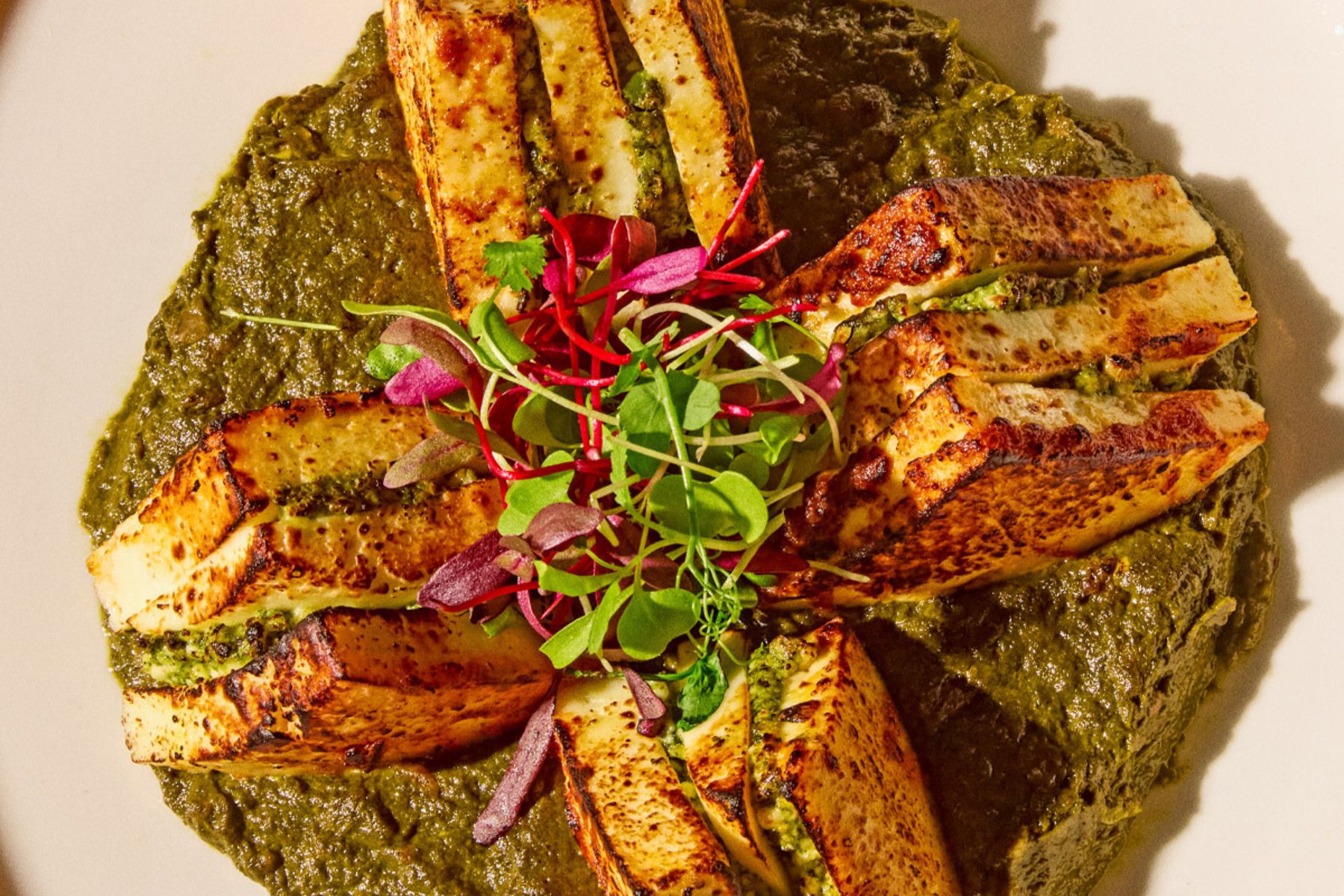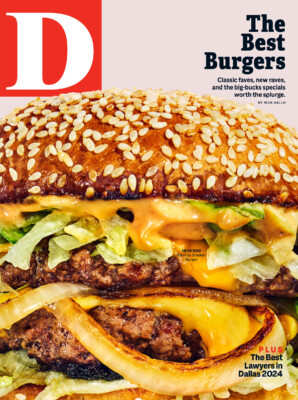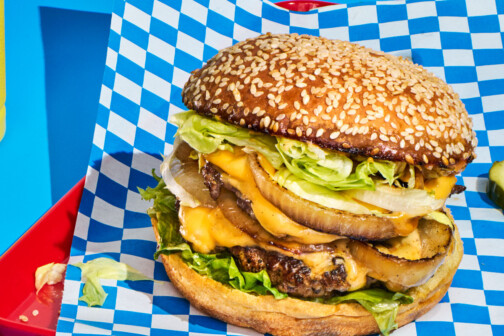For decades now, high-end, high-dollar Dallas restaurants have conformed to a certain set of expectations. Many assume that they cater to a specific slice of the population. But what if they’re missing out on thousands of customers who want to spend big bucks on dinner, drink spectacular cocktails, and feel like royalty for a night—people who don’t match the Dallas old-money stereotypes?
This is the theory behind a new destination restaurant in Las Colinas. Called Sanjh, it takes Indian food to new heights of price, technique, and swagger. And it’s packed just about every night with people who would never think of going to a steakhouse.
Sanjh promises “creative Indian” food, served up in a glamorous two-story lakeside dining room with a glass-walled kitchen that lets you watch the chefs at work. You’ll dine off beautiful India-made porcelain, be charmed by formally dressed staff, and even follow a dress code: “No open foot ware or short trousers for the gentlemen.”
You’ll also be dazzled by some of the most sophisticated cocktails in North Texas. Judged as a cocktail bar alone, Sanjh would rank in the Dallas area’s top five, and that might be an understatement. Consulting mixologist Yangdup Lama’s New Delhi bar, Sidecar, was ranked No. 26 on the World’s 50 Best Bars list in 2022. At Sanjh, Lama has created a dozen signature drinks. You can order a Cosmo, too, but you’d be missing out.
The gin-based Jaam e Aam glows orange with sweet mango nectar, but there’s also a savory aromatic intensity from cumin liqueur and black salt. The Bay of Bengal Gimlet adds a bit of chile pepper tincture to that classic. My personal weakness is for the Mausambi Lemonade, which deploys lime, not lemon, juice—plus tequila and a hit of hot chile pepper. Give me a fizzy, citrusy, spicy drink all summer long.
If you’re feeling bold, order the Chaat. The menu listing sounds like something from a laboratory, and my description isn’t going to be much more appetizing: it’s a tequila-based drink that tastes like you’re drinking cilantro chutney. The aroma is striking, to put it mildly. But, as savory and spicy as the drink is, it’s also mesmerizing. I’d go back for it. I will remember it for years.

Curls of smoke rise up around the shakargandi chaat appetizer, featuring starfruit and sweet potato.
With cocktail in hand, we can now learn what Sanjh means by “creative” Indian food. Its plates are more traditional than its drinks. In the global new wave of Indian fine dining, some restaurants, like London’s BiBi and Chicago’s Indienne, radically rethink the cuisine by allowing multiple Indian regions to collide on one plate, pushing classic dishes into new forms, or using the picture-pretty plating of an upscale French kitchen. Others, like Gymkhana in London and Semma in New York, go back to the roots but do so with cut-no-corners technique and sophistication.
Sanjh mostly falls in the second category. It offers buttoned-up presentations of well-known classics such as samosas, dosas, dal, and butter chicken. Biryani arrives still in its sealed pot, the lid pulled open tableside. Goat biryani’s meat is tender and peels easily off the bone, while the rice offers a maximalist, spice-heavy flavor. The paneer inside palak paneer’s gently spicy spinach sauce is made in-house and cut into triangles, like dainty teatime finger sandwiches. Butter chicken combines tandoor-grilled whole cuts with a deeply flavored sauce that has an intriguing sweet-sour tanginess.
Bharwan paneer tikka is a delight, its paneer made fresh and baked in the tandoor until the edges have a smoky char. Goat curry features super tender meat and a gravy that’s velvety in texture, thrilling in its spices, and darn near impossible to stop sopping up with bread. A special commendation, too, for the dal makhani, made a little lighter and sweeter with tomatoes and cream.
All of this is very good, but there is strangeness to the Sanjh experience. One reason is practical: the plates are big, and the tables are small. If you plan to share, servers divide up your meal for you, portioning out everyone’s bites. On my first visit, for example, my dinner plate had one cheese triangle from the palak paneer, one piece of butter chicken, one scoop of goat biryani, and one piece of naan. The result was that, after all the kitchen’s effort at presentation, it looked like I had visited a buffet.
I don’t know what the solution is, but I’d urge Sanjh to experiment. Even when a table is going to share its dishes anyway, it’s a shame to discard the striking visuals the kitchen creates.
It’s packed just about every night with people who would never think of going to a steakhouse.
A second hangup is that word in the slogan: “creative.” Is the butter chicken creative? Where, I asked a server on my latest visit, is the stuff nobody’s ever seen in Dallas before? She pointed unhesitatingly to a vegetarian appetizer: saag anjeer ke kebab. This is saag (spinach) chopped up with fresh figs and spices, rolled and shaped into bright green patties. (If it helps, imagine the shape and texture of a crab cake.) Sure enough, the savory-sweet combination of these kebabs is great fun—and something completely new.
That’s not the only novelty. Appetizer scallops are, frankly, huge—the size of coasters—and coated in a flavorful recheado sauce made with peri peri chiles, garlic, malt vinegar, jaggery, and spices. Between each scallop on the plate sits a charming little dumpling made from gram flour. Our server’s recommended “creative” main course was a velvety, gorgeously creamy korma sauce, poured over slices of duck breast, their skins made crispy through a slow sear in a cast-iron skillet.
Each dessert is listed on the menu with just one word of description, a word that hides an abundance of technique. Ghevar is a sort of mille-feuille, with layers of cheesecake-like cream and crispy-fried cake filled with air bubbles. The texture of this fluffy but crunchy cake is a bit like honeycomb candy. For garnish, Sanjh adds passionfruit, chocolate molded in the shape of tree branches, and pistachio—and then lights the dessert on fire at the table, although ours flickered for only a few seconds.
Now, here’s the challenge. Dessert is $25. That duck dish is $45 for two slices of duck, sauce, and a garnish. Palak paneer runs $35, a plain dosa with three dips $20, an appetizer set of four lamb chops $45. This is going to be a point of controversy in a city that still looks for $15 tikka masala. During our visits, the cost was not causing any slowdown in the bustling dining room. I am always happy to pay what an experience is worth, but for $150 per person, I can’t help wishing that the word “creative” described more than half the dishes.
The argument in favor of Sanjh’s price point is threefold. First, this food is time-consuming and laborious to make properly. Have you ever cooked dal makhani at home? The pot I made recently required four hours of frequent stirring. Butter chicken is even more intensive (and more rewarding). It demands one sauce made from scratch to serve as a marinade and then, hours or even a day later, another all-new sauce for service.
Second, everything at Sanjh is very good. I have only two real complaints. The lamb chop appetizer is wonderfully spiced but cooked past tenderness, and the wine list makes almost no attempt to match its bottles to the flavors of Indian food. It stars too many fruity, oaky reds that clash with heavy spices. At least there are some rieslings—and those jaw-droppingly great cocktails.
The final point is that the culinary traditions of India have as much right to be served in a fine-dining setting as any other. They offer infinite room for creativity, fusion, and attention to detail.
If you want proof that this menu can work, just look around Sanjh’s dining room. Before visiting, my guests and I wondered if the restaurant’s crowd would be the usual Dallas glitterati. Not so: almost every other customer was South Asian. Even on a Tuesday night, the room was buzzing with at least three birthday celebrations.
The crowd, more than the goat curry and spectacular cocktails, is what I’ll remember about Sanjh. Dallas keeps building identical new high-end restaurants for identical clienteles, while untapped audiences wait to spend at a place that’s made for them.
Our region’s community of more than 220,000 Indian Americans got tired of waiting for Dallas restaurateurs to recognize—and profit from—our city’s diversity. So they built their own glitzy destination. The rest of us could learn from Sanjh’s example.
This story originally appeared in the May issue of D Magazine with the headline “Creative License.” Write to [email protected].
Author









